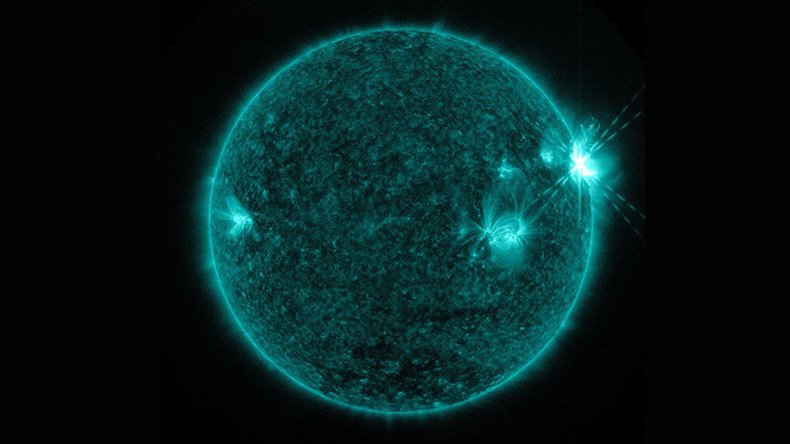3 solar flares in 24hrs: NASA captures stunning images of sun eruptions (PHOTOS)

The sun has been snapped emitting three powerful blasts of radiation in recent days, causing some disruptions in the Earth’s atmosphere. If strong enough, these solar events can interrupt GPS and communications signals around the world.
Solar flares are brief eruptions of intense high-energy radiation from the sun's surface. However, fear not, as “harmful radiation from a flare cannot pass through Earth's atmosphere to physically affect humans on the ground,” NASA says.
READ MORE: Scientists warn devastating solar storms could disable communications, electronics
The flares sprang from the surface of the sun on Sunday and Monday. Images of the phenomenon leaping out from the sun’s surface were captured by NASA’s Solar Dynamics Observatory, which constantly watches our galaxy’s glowing orb.
On April 2-3, @NASASun captured images of 3 solar flares that, if powerful, enough can affect GPS & communications: https://t.co/g6vqdJpaAapic.twitter.com/r2Ab74pjfW
— NASA (@NASA) April 3, 2017
The three flares were all classified as ‘M-class’ eruptions. M-class flares are a 10th the size of the most intense flares, which are X-class. Western Europe and the east coast of the United States and Canada were most affected by the communications disruptions.
M5.8-flare now! #Hamradio blackout & #GPS, #GNSS issues next 30+ min, especially UK, Western Europe, Eastern USA & Canada (colors in map)! pic.twitter.com/z856rLIeDO
— Dr. Tamitha Skov (@TamithaSkov) April 3, 2017
A strong enough flare could seriously affect electronic communications on Earth, potentially shutting down air travel and satellites.
READ MORE: Solar storm: How massive flare nearly caused WWIII
The phenomena were first observed in 1859 when the enormous ‘Carrington event’ was reported by British astronomer Richard Carrington. The flare was so powerful it could be seen with a naked eye, and knocked out telegraph systems in Europe and the US.
In more recent times, the largest flare came in November 2003 and was estimated to be an ‘X28’ flare.
Strong M5.83 solar #flare from #sunspot region 12644
— SpaceWeatherLive (@_SpaceWeather_) April 3, 2017
Follow live on https://t.co/3Xxrvc3cpApic.twitter.com/jwsY3fvbmg
The number provides more information about a flare’s strength. An X2 is twice as intense as an X1, an X3 is three times as intense, and so on. So an X28 is a staggering 28 times as intense as an X1. The latest batch comprised all M5 flares.












